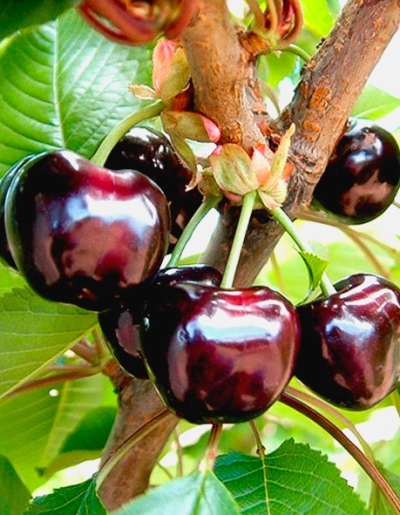
- Fruit shape: elongated-oval, abdominal suture small, hardly noticeable
- Foliage: good
- Peduncle: medium length and thickness
- Year of approval: 1959
- Growth type: vigorous
- Appointment: universal
- Yield: high
- Crown: wide, spreading, dense, slightly drooping, strongly branching
- Escapes: light brown with a gray bloom, no anthocyanin coloration
- Sheet: Above medium size, oval or oblong-ovate, dark green, of medium thickness, elastic, pointed, smooth, pubescent underneath
Sweet cherry French black has been known to gardeners for a long time and is widely grown in the southern regions of the country. And it is attractive, first of all, for its resistance to diseases and tasty, high-quality fruits.
Breeding history
The only thing known about the origin of the French black cherry variety is that it comes from Western Europe, from where it was brought to Russia back in the 40s of the last century. There is no information about the history of breeding. The North Caucasian Federal Scientific Center for Horticulture, Viticulture, Winemaking (Krasnodar) became the originator who applied for a permit for use.
The application was made by the organization in the distant 41st. Since 1947, the culture has been under state variety testing, after which in 1959 it was included in the State Register for the North Caucasus region (including the Krasnodar Territory and the Republic of Adygea). Today it is the most common late-ripening variety grown in the Krasnodar Territory.
Description of the variety
French Black is a vigorous tree with a spreading, wide-rounded, well-leafy, dense crown that hangs slightly and branches heavily. Annual shoots are light brown with a gray bloom. Leaves are oval, 161x78 mm in size, their thickness is average, they have a strongly pointed tip, serrate edges. The surface of the leaf is smooth from above, from below with pubescence on the veins. The leaf plate is slightly raised at the edges.
White, medium-sized flowers are collected in inflorescences of 2-4 pieces. The culture bears fruit on uneven-aged bouquet branches and partially on last year's shoots.
Fruit characteristics
The berries are very beautiful and shiny. They are dark red, almost black. All ripen at the same time, are not subject to cracking. They have a dry separation from a non-thick stalk of medium length. The fruits are quite large: 6.5–7.5 g, oval in shape, elongated. The abdominal suture is almost invisible.
Taste qualities
The taste characteristics of European cherries are also excellent. The sweet berry has a dessert taste, the red pulp is juicy and quite dense. Medium-sized stone separates well from the pulp. Berry composition:
- 13.3% - dry matter;
- 18.5% sugar;
- 0.8% - acids;
- 7.7 mg / 100 g - ascorbic acid.
The purpose of the product is universal. This is a wonderful dessert, as well as beautiful berries will decorate any confection. Sweet cherries can be frozen, processed in any way to get a delicious homemade product, such as jam, juice or compote.
Ripening and fruiting
French black ripens late, at the very end of June. The tree begins to bear fruit only at 6 or 7 years. However, it lives for a long time: a quarter of a century.

Yield
Cherry productivity is high. Average yields are in the range of 8.5-10.5 t / ha, the maximum reaches 18-19 t / ha.
Self-fertility and the need for pollinators
The crop is self-fertile and requires planting trees nearby to aid in cross-pollination. Among the most effective varieties for French black, it is worth highlighting the following varieties:
- Melitopol;
- Large-fruited;
- Beauty of the Kuban;
- sweet cherry Napoleon black;
- Ramon Oliva;
- Prestigious.
Growing and care
The cherry tree of the described variety must be watered 3 times per season: before flowering, in the middle of the summer period, before winter. French black will absorb 2 buckets of water.
Mature trees are fed in early spring. The best option: 15 g each of urea, superphosphate and potassium sulfate must be embedded in the ground. After the harvest is harvested, the cherries need to be sprayed with a solution: 10 g of phosphorus and potassium fertilizer are dissolved in 10 liters of water.
French black requires annual pruning. In this case, the conductor is shortened, as well as the skeletal branches. All frozen, dry branches, as well as shoots that thicken the crown, are removed.
As for shelter for the winter, only young trees will need them. You can cover it with either agrofibre or simply spruce branches. The trunks from the attacks of rodents will help protect the roofing material or net.




Disease and pest resistance
The variety is quite resistant to the main fungal diseases: coccomycosis, moniliosis, perforated spot. It has medium resistance to cherry fly attacks.

Requirements for soil and climatic conditions
French black in extreme conditions is capable of showing a fairly high winter hardiness of both wood and generative buds. However, the buds are unstable to the spring cold snap, during flowering the flowers have an average resistance, however, flowers rarely fall under frost. Drought resistance of the culture is high.
































































